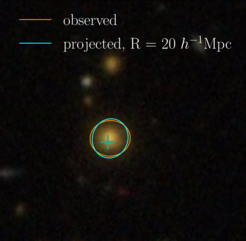Do massive red elliptical galaxies line up?
Are galaxy orientations distributed randomly in the cosmos? What appears to be a simple question might not only shed light on our understanding of galaxy and cluster formation, but also further our knowledge of cosmological models. MPA scientists and collaborators attempt to settle this question through the first direct, field-based measurement of whether and how massive red elliptical galaxies align with the tidal field of large scale structure. Their result confirms predictions of the (linear) alignment model of galaxy intrinsic alignment. The newly presented method also opens up new avenues for cosmology and astrophysics.
Our current picture of structure formation in the standard cosmological model Lambda-CDM (Cold Dark Matter with a cosmological constant Lambda) involves a large-scale cosmic web where spherical matter over-densities collapse under their own gravity. The collapse forms a Dark Matter halo that further hosts the galaxies, including one central massive red elliptical and multiple satellites. Assuming this scenario is correct, one can picture the following: as the collapse occurs in an external, non-uniform gravitational field, the halos can be squeezed or stretched such that their shapes and orientations become elongated and align with this external tidal force (Fig. 1). Such an external tidal field is very common due to the large-scale distribution of matter within the cosmic web. If the shape of a massive central galaxy then tends to follow that of its host Dark Matter halo, its shape should intrinsically align and trace the tidal field of the large-scale structure.

Further, the intrinsic alignment property of galaxies is typically a significant source of systematics in cosmic shear analyses. These measure how the shapes and orientations of background galaxies are systematically distorted and sheared by projected distributions of foreground masses, through the weak gravitational lensing effect. This kind of measurement (of the extrinsic alignment of background galaxies) provides a complementary and competitive constraint on cosmological parameters, as it directly probes the total matter distribution. However, it is important that the intrinsic alignment of those background galaxies is modelled and accounted for properly.
Recently, an international team co-led by Eleni Tsaparazi (PhD candidate, Stockholm University) and Minh Nguyen (MPA PhD alumni, now a postdoctoral research fellow at LCTP, Michigan) has measured and detected the intrinsic alignment of massive red elliptical galaxies through one-to-one (cross-)correlations between their shapes and their surrounding large-scale tidal fields. For the first time, this field-based measurement of galaxy intrinsic alignment was obtained in two steps:

First, the team infers the three-dimensional tidal field – as a function of the smoothing scale in the inference – within the volume observed by the SDSS-BOSS survey, while properly accounting for uncertainties and systematics such as survey geometries, selection functions and foregrounds. This amounts to hundreds of realizations of the large-scale tidal field compatible with the BOSS LOWZ and CMASS galaxy samples.
Second, the team develops a robust Bayesian inference framework that, at each scale and for each galaxy in a sub-sample of LOWZ galaxies, compares all tidal field realizations to the galaxy shape, both projected to the plane perpendicular to the line of sight (Fig. 2). The framework further allows them to optimally extract the galaxy intrinsic alignment signal for a given theoretical model of the alignment. In particular, the team studies and constrains the linear alignment model wherein the alignment signal is linearly proportional to the strength of the large-scale tidal field at the location of the given galaxy.
Following this two-step-process, the team detects a highly significant signal that galaxies in the LOWZ sample, which are luminous red ellipticals, indeed tend to align with the large-scale tidal field around these galaxies. The signal is significant on a broad range of smoothing scales – reaching 4 sigma significance at 20 Mpc/h – with its amplitude being relatively stable on all scales considered, and consistent with the prediction of the linear alignment model.

In a crucial validation test of the detection the team shuffles the galaxies and measures a null signal, i.e. no correlation between a galaxy shape and its local tidal field, on all scales considered. This shows that the non-negligible sources of systematics are all accounted for properly in the study. The team also detects no evolution of the linear alignment amplitude with luminosity, color or redshift.
The result of this study and its two-step approach promises fascinating avenues for cosmology and astrophysics. On the one hand, this type of cross-correlation measurement can serve as a cross-validation of the standard model Lambda-CDM, which is typically assumed in the first step. On the other hand, in the second step, different intrinsic alignment models can be studied and constrained with a minimal set of modeling assumptions at the field level. This will further not only our knowledge of galaxy formation, but also our ability to constrain cosmological parameters through the aforementioned weak lensing analyses.














